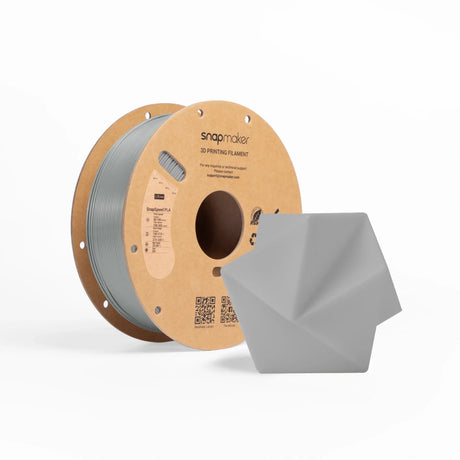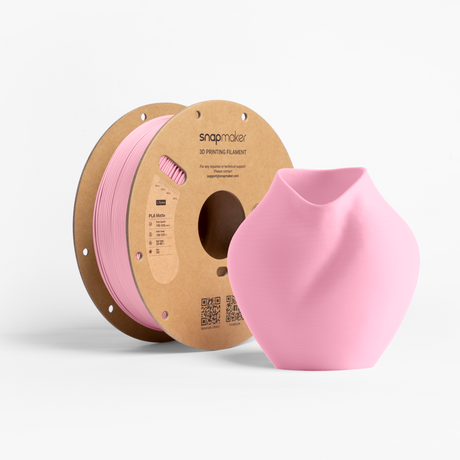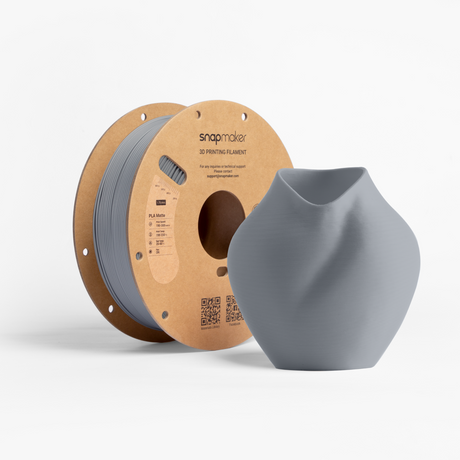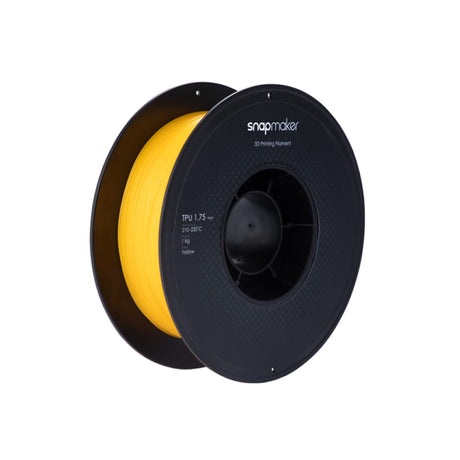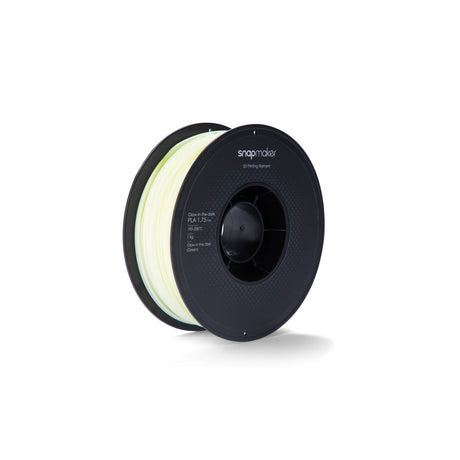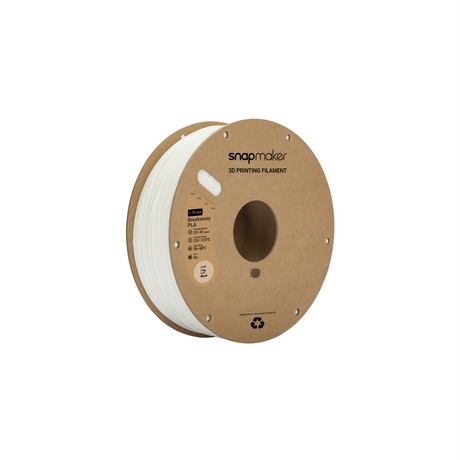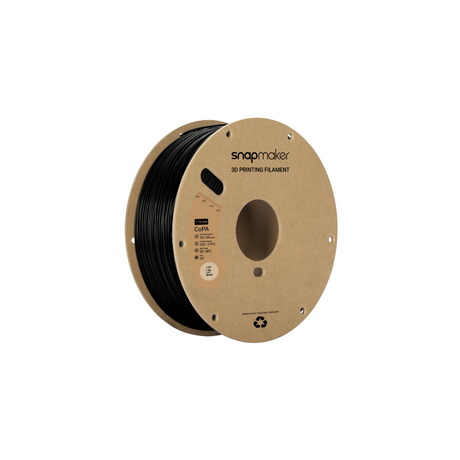Grünes PLA-Filament, das im Dunkeln leuchtet (1kg)
€22,99 EUR€31,99Grundpreis /Nicht verfügbarAuf LagerSchwarzes High Flow TPU95 Filament (1kg)
€40,99 EUR€50,99Grundpreis /Nicht verfügbarBegrenzter Vorrat
FAQs
1. Wie groß ist der Durchmesser des 3D-Drucker-Filaments von Snapmaker?
Das Snapmaker 3D-Drucker-Filament hat einen Durchmesser von 1,75 mm und ist mit den meisten 3D-Druckern kompatibel.
2. Wie wähle ich das richtige 3D-Drucker-Filament für mein Projekt aus?
Um das passende 3D-Drucker-Filament auszuwählen, sollten Sie sich zunächst mit den verschiedenen Filamenttypen, ihren Eigenschaften und Anwendungsbereichen vertraut machen. Anschließend bewerten Sie die Druckeigenschaften, die Kosten und die Verfügbarkeit jedes Filaments, um eine fundierte Entscheidung auf Basis der spezifischen Anforderungen Ihres Projekts zu treffen.
Hinweis: Snapmaker 3D-Drucker unterstützen ausschließlich Filamente mit einem Durchmesser von 1,75 mm.
3. Welche Arten von 3D-Drucker-Filamenten unterstützt Snapmaker?
• Snapmaker 2.0: PLA, ABS, PETG, TPU (Härte ≥ 95 Shore A), holzgefülltes PLA sowie weitere Filamente, die derzeit getestet werden.
• Snapmaker Artisan: PLA, ABS, ASA, PETG, TPU (mit Härte ≥ 90 Shore A), Breakaway-Stützmaterial für PLA, PVA, HIPS und Nylon; carbonfaserverstärktes Nylon und glasfaserverstärktes Nylon (erfordert gehärtete 0,4 mm Hot Ends).
• Snapmaker J1/J1s: PLA, ABS, HIPS, PC, TPU (Härte ≥ 90 Shore A), TPE, PETG, ASA, PP, PVA, PA, PA-GF, PA-CF.
• Snapmaker U1: Standardmäßig PLA, PETG, TPU und PVA; mit optionaler Abdeckung und gehärteter Stahldüse zusätzlich PET, ABS, ASA, PC, PA, PA-CF und PA-GF (weitere Optionen in der Testphase). Mehr erfahren.
4. Welches ist das am häufigsten verwendete 3D-Drucker-Filament?
Polylactid (PLA) ist das am häufigsten verwendete Filament, da es leicht zu drucken ist, biologisch abbaubar ist und bei niedrigen Temperaturen schmilzt.
Aktuell bieten wir schwarzes PLA, weißes PLA, Holz-PLA und grün leuchtendes PLA-Filament an.
5. Wie lange ist die Lebensdauer von 3D-Drucker-Filamenten?
Die Lebensdauer von 3D-Drucker-Filamenten beträgt in der Regel 1 bis 2 Jahre. Diese Dauer kann je nach Filamenttyp, Lagerungsbedingungen und Umwelteinflüssen variieren. Eine sachgerechte Aufbewahrung mit professionellem Zubehör wie dem SnapDryer kann die Nutzungsdauer deutlich verlängern.
6. Gibt es umweltfreundliche 3D-Drucker-Filamente?
Ja, unser PLA (einschließlich Holz-PLA und grün leuchtendes PLA) wird aus biologisch abbaubaren, nachwachsenden Rohstoffen wie Maisstärke oder Zuckerrohr hergestellt. Zudem entsprechen diese Materialien der RoHS-Richtlinie (Beschränkung gefährlicher Stoffe).
7. Wofür wird PETG-Filament verwendet?
PETG-Filament vereint die Funktionalität von ABS mit der Zuverlässigkeit von PLA. Aufgrund seiner Robustheit eignet es sich ideal für mechanische Bauteile, Schutzhüllen sowie Anwendungen im Außenbereich oder bei chemischer Belastung. Snapmaker bietet derzeit hochwertiges PETG-Filament in Rot und Blau an, das mit den meisten 3D-Druckern kompatibel ist.
8. Wie trocknet man 3D-Drucker-Filament?
Um feuchtes 3D-Drucker-Filament zu trocknen, können Sie einen Backofen, einen Lebensmitteltrockner, einen Früchtetrockner, ein beheiztes Druckbett oder einen Haustierföhntrockner verwenden. Ausführliche Anleitungen finden Sie in den bereitgestellten Trocknungshinweisen für 3D-Drucker-Filamente.
Alternativ können Sie den SnapDryer verwenden – eine professionelle Lösung zum sicheren und effizienten Trocknen und Lagern von 3D-Drucker-Filamenten.
FAQs
1. Wie groß ist der Durchmesser des 3D-Drucker-Filaments von Snapmaker?
Das Snapmaker 3D-Drucker-Filament hat einen Durchmesser von 1,75 mm und ist mit den meisten 3D-Druckern kompatibel.
2. Wie wähle ich das richtige 3D-Drucker-Filament für mein Projekt aus?
Um das passende 3D-Drucker-Filament auszuwählen, sollten Sie sich zunächst mit den verschiedenen Filamenttypen, ihren Eigenschaften und Anwendungsbereichen vertraut machen. Anschließend bewerten Sie die Druckeigenschaften, die Kosten und die Verfügbarkeit jedes Filaments, um eine fundierte Entscheidung auf Basis der spezifischen Anforderungen Ihres Projekts zu treffen.
Hinweis: Snapmaker 3D-Drucker unterstützen ausschließlich Filamente mit einem Durchmesser von 1,75 mm.
3. Welche Arten von 3D-Drucker-Filamenten unterstützt Snapmaker?
• Snapmaker 2.0: PLA, ABS, PETG, TPU (Härte ≥ 95 Shore A), holzgefülltes PLA sowie weitere Filamente, die derzeit getestet werden.
• Snapmaker Artisan: PLA, ABS, ASA, PETG, TPU (mit Härte ≥ 90 Shore A), Breakaway-Stützmaterial für PLA, PVA, HIPS und Nylon; carbonfaserverstärktes Nylon und glasfaserverstärktes Nylon (erfordert gehärtete 0,4 mm Hot Ends).
• Snapmaker J1/J1s: PLA, ABS, HIPS, PC, TPU (Härte ≥ 90 Shore A), TPE, PETG, ASA, PP, PVA, PA, PA-GF, PA-CF.
• Snapmaker U1: Standardmäßig PLA, PETG, TPU und PVA; mit optionaler Abdeckung und gehärteter Stahldüse zusätzlich PET, ABS, ASA, PC, PA, PA-CF und PA-GF (weitere Optionen in der Testphase). Mehr erfahren.
4. Welches ist das am häufigsten verwendete 3D-Drucker-Filament?
Polylactid (PLA) ist das am häufigsten verwendete Filament, da es leicht zu drucken ist, biologisch abbaubar ist und bei niedrigen Temperaturen schmilzt.
Aktuell bieten wir schwarzes PLA, weißes PLA, Holz-PLA und grün leuchtendes PLA-Filament an.
5. Wie lange ist die Lebensdauer von 3D-Drucker-Filamenten?
Die Lebensdauer von 3D-Drucker-Filamenten beträgt in der Regel 1 bis 2 Jahre. Diese Dauer kann je nach Filamenttyp, Lagerungsbedingungen und Umwelteinflüssen variieren. Eine sachgerechte Aufbewahrung mit professionellem Zubehör wie dem SnapDryer kann die Nutzungsdauer deutlich verlängern.
6. Gibt es umweltfreundliche 3D-Drucker-Filamente?
Ja, unser PLA (einschließlich Holz-PLA und grün leuchtendes PLA) wird aus biologisch abbaubaren, nachwachsenden Rohstoffen wie Maisstärke oder Zuckerrohr hergestellt. Zudem entsprechen diese Materialien der RoHS-Richtlinie (Beschränkung gefährlicher Stoffe).
7. Wofür wird PETG-Filament verwendet?
PETG-Filament vereint die Funktionalität von ABS mit der Zuverlässigkeit von PLA. Aufgrund seiner Robustheit eignet es sich ideal für mechanische Bauteile, Schutzhüllen sowie Anwendungen im Außenbereich oder bei chemischer Belastung. Snapmaker bietet derzeit hochwertiges PETG-Filament in Rot und Blau an, das mit den meisten 3D-Druckern kompatibel ist.
8. Wie trocknet man 3D-Drucker-Filament?
Um feuchtes 3D-Drucker-Filament zu trocknen, können Sie einen Backofen, einen Lebensmitteltrockner, einen Früchtetrockner, ein beheiztes Druckbett oder einen Haustierföhntrockner verwenden. Ausführliche Anleitungen finden Sie in den bereitgestellten Trocknungshinweisen für 3D-Drucker-Filamente.
Alternativ können Sie den SnapDryer verwenden – eine professionelle Lösung zum sicheren und effizienten Trocknen und Lagern von 3D-Drucker-Filamenten.








